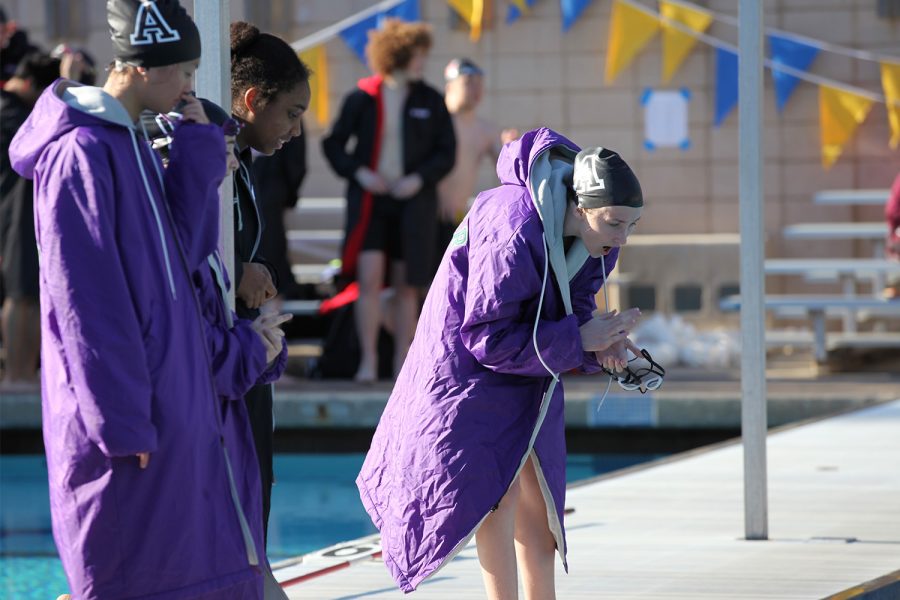To club or not to club: Varsity, JV Swim find community between small practices, scattered meets
Photo credit: Archer Athletics
Senior Lily Prokop cheers on her teammate at the first swim meet of the season. As club and non-club athletes on the swim team do not practice together, meets are a unique time to build connections within Archer’s swim community.
April 11, 2023
While 13 varsity and 13 JV swimmers make up the largest Archer swim team to date, not all athletes attend school practices. Unlike other varsity sports, athletes in club swim can attend their club practices, whereas non-club athletes take part in school practices in the off-campus pools and on dry land five days a week. Most club athletes choose to only attend their club practices, but a few attend both Archer and club practices.
In the few weeks of the swim season, all swimmers practiced together. Head Coach Wilma Wong sorted players between varsity and JV by the first meet, assigning the faster swimmers to the varsity events.
Wong said the division between the club and non-club swimmers is minor and is more of an aid than a hindrance. With a two-month season, Wong said her goal is to get her athletes as fast as they can in the shortest amount of time possible.
“I know there are some teams that actually require club swimmers to show up, but I don’t do it because it’s not to their benefit to be with people with such a wide range of abilities,” Wong said. “This way the club kids are on their own and the people who are practicing, I can segment it off and give them as much attention as they need.”
Since Archer does not have a pool on campus, swimmers attending Archer practices travel to Santa Monica College on Monday and Tuesday evenings and to Palisades High school on Saturdays. Swimmers take the late bus to the Santa Monica stop on Bus 801 to enter the aquatic center.
At the end of every practice, Wong has each of the members state what they did well at practice that day and said it has instilled a mindset of positivity in the team.
“It’s easier to beat yourself up than to prop yourself up and say good job,” Wong said. “So the goal is to train the mind to focus on what we did well, and, instead of saying what you did wrong, you say what can we improve upon … and you train the mind to be a winner.”
At the meets where all varsity and JV swimmers gather, Wong encourages camaraderie by doing group warm-ups such as the Emotional Freedom Technique, an Olympic technique of tapping on the body’s acupressure points to relieve anxiety.
JV swimmer Quinn Agard (’26) is on Archer swim for the first time this year, being one of the few swimmers without any club experience. Agard said she continues to work towards her personal goal of improving her dives and strokes thanks to the help of others on the team.
“There is a clear difference between those … who have more experience in [swimming] than those who don’t,” Agard said. “But they’re very helpful, and they aren’t separated from us. They like to help, and they really do enjoy telling you what you’re doing wrong and how to improve it, and I really appreciate that.”
Varsity swimmer Lucine Stephan (’25) said the lane you swim in is indicative of your skill level.
“There is an unspoken … hierarchy,” Stephan said. “I’m in one of the faster lanes because [there are] more JV swimmers on the team that come to practice, and [I’m] varsity. There’s often a lot of club swimmers that only attend club practices and attend school swim meets.”
As a synchronous swimmer, swimmers who collectively perform water aerobic routines, Stephan practices for an additional hour-and-a-half before the Archer practice on Saturday to work on both dry land and dance techniques in the pool for her synchronous team. She said synchronous swimming not only branches from elements of competitive swimming but also gymnastics and dance, adding further techniques for her to prioritize.
“When I go to each practice, I look at [competitive swim and synchronous swim] … and how I need to improve and be the best I can for both of my teams at once. And sometimes that can be pretty pressuring,” Stephan said, “because when you got to focus on one sport, you got to hone in that ability more, and you’re able to improve faster. It’s a lot more gradual change for me.”
Stephan said even with the separation and experience differences, the challenge of swimming competitively unites the entire team.
“When you’re in a group, you all just understand each other because you are all going through the same exact thing at one time,” Stephan said. “I still feel connected … because we’re all still trying to get through it at the same time. We all still have [the] same events. We all know what it’s like to be on a swim team. So you still really feel like you are part of a team, even if you don’t see the other members as much.”
The most recent meet was their Liberty League meet against Milken, de Toledo, Buckley, AGBU and Oakwood with an overall win and the team’s next meet is today against Crossroads.









